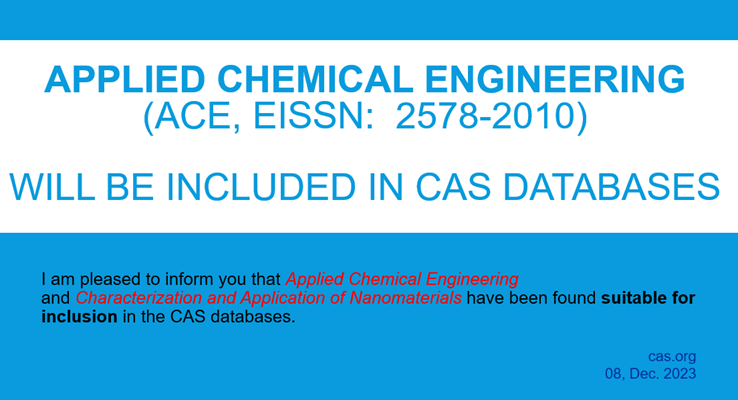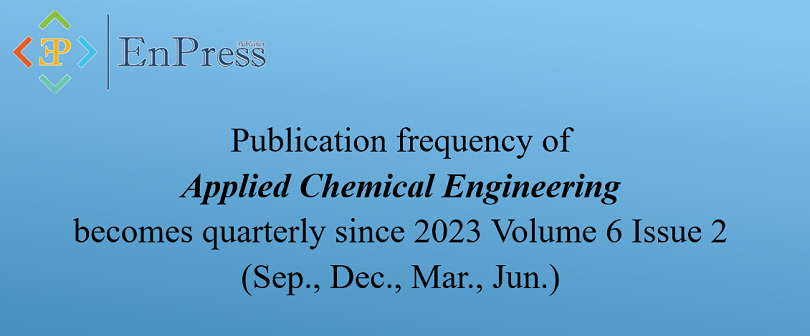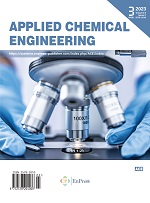2578-2010 (Online) Journal Abbreviation: Appl. Chem. Eng. | Applied Chemical Engineering (ACE) is an international open-access academic journal dedicated to publishing highly professional research in all fields related to chemical engineering. All manuscripts are subjected to a rigorous double-blind peer review process, to ensure quality and originality. We are interested inthe original research discoveries. This journal also features a wide range of research in ancillary areas relevant to chemistry. ACE publishes original research articles, review articles, editorials, case reports, letters, brief commentaries, perspectives, methods, etc. The research topics of ACE include but are not limited to: 1. Analytical Chemistry 7. Quantum chemistry method 2. Chemical Engineering 8. Environmental chemical engineering 3. Materials chemistry 9. Bio-energy, resources, pollution 4. Material synthesis 10. Reaction kinetics 5. Catalysis 11. Nanotechnology and bioreactors 6. Process chemistry and technology 12. Surface, coating and film
Starting from Volume 7, Issue 2 of 2024, Applied Chemical Engineering (ACE) will be published by Arts and Science Press Pte. Ltd. Please turn to the journal website(https://ace.as-pub.com/index.php/ace) for new submissions. Previous submissions will be still handled via the EnPress Publisher OJS. |
Vol 7, No 1 (Published)
Table of Contents
The development of polyethersulfone (PES) membranes to improve membrane performance can be done in various ways; one is by combining two types of additives (organic and inorganic) in one dope polymer solution. In this study, researchers analyzed the effect of combining polyethylene glycol hexadecyl ether (PEG-HE) as an organic additive and nanocarbon as an inorganic additive on the characteristics and performance of PES membranes. The membrane performance test includes analysis of pure water flux and rejection of synthetic fertilizer factory wastewater (Mg2+) with a concentration of 300 ppm. The membrane characterization was carried out by analyzing the morphology of the membrane structure using Scanning Electron Microscopy (SEM), water contact angle (WCA), porosity, and membrane pore size. Ultrafiltration experiment showed that the modified PES membrane with PEG-HE and Nanocarbon had the highest pure water flux. The most significant rejection coefficient of 96.88% was found in an ultrafiltration experiment using pure PES membranes. The characteristic of other membranes will be described in detail in this article.
Al-Mg surface doped silicon, germanium and tin is theoretically studied using first-principles density functional theory (DFT) at the CAM-B3LYP/EPR-III, LANL2DZ,6-31+G(d,p) level of theory to explore the chemical adsorption and corrosion inhibition of organic carbenes through coating process. The fluctuation of NQR is estimated the inhibiting role of pyridine and its derivatives (picoline, 3-picoline,4-picoline,2,4-lutidine) for (Si, Ge, Sn)-doped Al-Mg alloy nanosheet due to concerning nitrogen in the benzene ring of related heterocyclic compounds becoming close to the monolayer nanosurface of Al-Mg-X (X = Si, Ge, Sn) nanoalloys. The NMR spectroscopy remarks that (Si, Ge, Sn)-doped Al-Mg alloy nanosheet has maximum band wavelengths approximately between 10 ppm–2000 ppm accompanying the sharpest peaks for inhibitors → Al-Mg-X which are between 10 ppm–100 ppm. IR spectroscopy has exhibited that (Si, Ge, Sn)-doped Al-Mg alloy nanosheet with the fluctuation in the frequency of intra-atomic interaction leads us to the most influence in the vicinage atoms generated due to inter-atomic interaction. The maximum IR spectrum for complexes of [inhibitor → Al-Mg-X (X = Si, Ge, Sn)] is observed in the frequency range between 500 cm−1–3500 cm−1. This work exhibits that proper monitoring of the coating mechanism by Langmuir adsorption can illustrate inhibiting the aluminum nanoalloys corrosion through an investigation of their structural and thermodynamic properties. This work investigates the characteristics, band structure, and projected density of state (PDOS) of Al-Mg nanoalloy doped with Si, Ge, Sn elements for increasing the corrosion inhibition of the surface through adsorption of organic molecules of carbenes in the surface coatings process. This article can be helpful in a range of applications which uses Al-Mg alloy for the study of energy storage and adsorption of air pollution or water contamination. Many different approaches such as surface coatings, alloying and doping can be adopted to protect the surface.
Upazilla Health Complex (UHC) offers the primary level health care facilities for rural communities. Every day thousands of patients come here for health care. The Health complex needs 24 hours electric supply. The national Grid cannot provide continuous electricity supply. Rural areas face various disturbance such as load shedding, blackouts problems and bad weather situation. In this paper, we report on the techno-economic assessment of net metering based On-grid photovoltaic system for Kaunia Upazila Health Complex in Rangpur District, Bangladesh. The analysis is based on the grid-connected photovoltaic system without battery storage. The HOMER software is used to obtain the overall analysis and the load study is carried out by HOMER powering tools. It suggests that the selected health complex requires a 34 kW PV system. The system’s net present cost (NPC) and the levelized cost of energy (COE) are $35,524 and $0.048 respectively. In this proposed system, renewable energy provides 99% of the total power requirements, while the generator and grid provide only 1%. The system produces 53,736 kWh a year of electricity where the system’s surplus electricity is 3226 kWh per year which can be sold to the national grid using a net-metering system.
Acidic sulphate bath having ZnSO4, TiSO4 and sulphamic acid, was optimized for the deposition of bright Zn-Ti coating on mild steel. The effect of current density, on deposit characters, such as corrosion rate, thickness, and hardness were discussed. Potentiodynamic polarization and electrochemical impedance spectroscopy (EIS) methods were used to evaluate the corrosion properties of the deposit. The composition of deposits was determined by energy dispersive X-ray (EDX) analysis. Scanning electron microscopy (SEM) was used to examine the surface topography of the deposited layer. Atomic force microscopy (AFM) was used to determine the surface roughness. A new and low-priced sulphate bath, for bright Zn-Ti coatings on mild steel has been proposed, and the results indicate better corrosion resistance properties, and these coatings can be used for biomedical tools like Tuning fork, etc, applications.
Biomethanol, a renewable and sustainable alternative to traditional fossil-fuel-derived methanol, has garnered considerable attention as a potential solution to mitigate greenhouse gas emissions and dependence on non-renewable resources. The utilization of biocatalysts in biomethanol production offers a promising avenue to achieve environmentally friendly and economically viable processes. Paper highlights the biocatalytic pathways involved in biomethanol synthesis. Particular emphasis is placed on microbial biocatalysts, such as methanogenic archaea and certain bacteria, which possess the unique capability of converting carbon dioxide and hydrogen into methanol through a series of enzymatic reactions. Additionally, enzyme-based systems derived from various microorganisms and genetically engineered organisms are also discussed as potential biocatalysts for biomethanol synthesis. Paper also delves into the current challenges and limitations faced in harnessing biocatalysts for biomethanol production. These challenges include substrate availability, low conversion rates, enzyme stability, and process scalability. Several strategies to address these issues are highlighted, including metabolic engineering, synthetic biology, and bioprocess optimization techniques. The advantages of utilizing biocatalysts for biomethanol production are outlined. Biocatalytic routes offer the advantage of operating under mild conditions, which reduces energy consumption and minimizes the production of unwanted by-products. Furthermore, the utilization of renewable feedstocks, such as carbon dioxide captured from industrial emissions or waste streams, enhances the sustainability of the process. The final section discusses future prospects and potential research directions in the field of biocatalytic biomethanol production. Advances in biotechnology, omics technologies, and computational modeling are poised to accelerate the discovery and optimization of novel biocatalysts, thereby unlocking the full potential of biomethanol as a sustainable fuel and chemical precursor. The use of biocatalysts for biomethanol production offers an attractive approach to establish a green and circular economy. With ongoing research and technological advancements, the field holds significant promise for reducing carbon emissions and transitioning towards a more sustainable energy landscape. However, to fully realize the potential of biocatalytic biomethanol production, interdisciplinary collaboration and concerted efforts are required to address existing challenges.
Titanium-based biomedical implants are widely used owing to their biocompatibility, corrosion resistance and mechanical strength. Although, they still face challenges such as poor osseointegration and implant failure caused by corrosion. To address these challenges, various surface treatments have emerged to enhance the biocompatibility and corrosion resistance of titanium implants. This review article presents a concise overview of the innovative surface treatments for enhanced corrosion resistance and biocompatibility of titanium-based biomedical implants. The surface treatment briefly discussed includes physical, chemical, and biological treatments, such as plasma spraying, anodization, electrochemical deposition, and biomimetic coating. Furthermore, this article also highlights the importance of surface treatments to enhance the biological performance of titanium-based implants. This review provides insights for researchers and clinicians in the field of titanium-based biomaterials and may contribute to the development of more effective and durable biomedical implants.
Neurological disorders (NDs) such as Alzheimer’s disease (AD), Parkinson’s disease (PD), epilepsy, despondency, and dementia have been evidenced as a rising concern among diverse geographical regions. Brain-related diseases are currently the main concern because they increase mortality and morbidity in the elderly. Regardless of the continual efforts by modern scientists to develop a promising pharmacological or surgical management, the outcome has not been satisfactory. Also, due to synthetic drugs’ associated side effects, scientists have taken the initiative to consider using natural compounds as an alternative. Hence, they obtain pretty effective results by using natural compounds. Natural ingredients are synthesized from a variety of plant and animal sources. These natural ingredients cure brain diseases through a variety of mechanisms. For effective medication advancement, the molecules must go through preliminary clinical systems that require some investment and significant speculation. In this situation, cheminformatics is fundamental in diminishing time and venture. Cheminformatics methods play a significant role in these issues, including 3-dimensional quantitative structure-activity relationship 3D-(QSAR), virtual screening, docking, molecular dynamic studies, and quantum chemical studies. The vital purpose of this study is to disclose different types of NDs and the neuroprotective effect of several natural products for experimental and cheminformatics-based therapy. Natural products like green tea, flavonoids, and ginseng are discussed as effective neuroprotective products. However, more investigation is expected to comprehend the better utilization of regular items in future exploratory and cheminformatics-based treatment for NDs.
Announcements
This journal will be jointly published by Enpress Publisher and Arts and Science Press (https://ojs.as-pub.com/index.php/index/index). |
|
Starting from Volume 7, Issue 2 of 2024, Applied Chemical Engineering (ACE) will be published by Arts and Science Press Pte. Ltd. Please turn to the journal website(https://ace.as-pub.com/index.php/ace) for new submissions. Previous submissions will be still handled via the EnPress Publisher OJS. |
|
| Posted: 2024-01-25 | |
ACE is included in CAS databases! |
|
 |
|
| Posted: 2023-12-11 | |
Publication frequency becomes quarterly |
|
 |
|
| Posted: 2023-09-12 | |
| More Announcements... |










 ISSN:
ISSN:  Open Access
Open Access